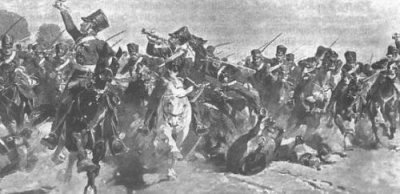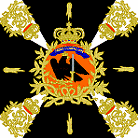
Charge of Prussian cavalry in 1813


{Preußische Kavallerie
während der Napoleonischen Kriege}
1. The Prussian Cavalry
2. Horses
3. Organization.
4. Cavalry of Royal Guard.
5. Cuirassiers.
6. Dragoons.
7. Uhlans.
8. Hussars.
9. Landwehr Cavalry.

|
The Prussian Cavalry.
During campaign the column of march was by 3s but all movement on the battlefield was done by 2s. Cavalry regiment could be formed in several different ways: in echelon, in column with intervals, and in column without intervals (companies placed "nose to tail"). When in line the men were drawn up stirrup to stirrup in 2 ranks. The quietest horses were in the front rank. The flankers and riflemen were usually sent out to engage the enemy at 150 - 200 paces away from their parent regiment. The 1812 Regulations prevented the Prussian cavalry from taking the initiative and was seen as a mere appendage of the infantry. In battle the cavalry was usually deplyed behind infantry or on the flanks, only to be used to exploit success achieved by the infantry and not "to go out on its own." At least theoretically they were to await the attack of the French cavalry. Only when the enemy was much weaker the Prussian cavalrymen were to attack the enemy. In such case they attacked one or both flanks of the French. In reality the Prussian cavaliers were far more aggressive. When more than one cavalry regiment came together then the cuirassiers stood on the right flank, then dragoons, next to them were hussars and on the left flank stood uhlans.
When attacking French infantry formed in squares, the attack was to be made on the corners.
Prussian cavalry enjoyed several great successes against French infantry.
Weapons
Flags
|
|
Horses.
The Prussian horse Trakhener came from Eastern Prussia (today Poland). The Trakheners became Prussian army chargers and of quality unsurpassed in Europe. They were also purchased or taken by Napoleon. Most common colors: bays, chestnuts, blacks.
In 1815 manpower shortage were acute, but the scarcity of horses was worse.
Remount depots had been emptied due to the enormous demands of the last two campaigns.
In 1815 there were problems with the Poles who were reluctant to sell their fine horses to the Prussians. The King threatened to requisition the mounts.
|
|

Cavalry of the Royal Guard.
In 1813 there were 2 Guard cavalry regiments: Horse Guard and Gurd Light Cavalry Regiment.
Both regimentshad a normal establishment of 4 squadrons. However, because of "popular subscription" to the war squadrons known as "freiwilligee jagers" were raised. These were wealthy young men who wished to liberate the fatherland. (Nafziger - "Lutzen and Bautzen" p 178)
In March 1815 were formed Guard Uhlan Regiment, Guard Dragoon Regiment and Guard Hussar Regiment.
|
|

Cuirassiers
In 1806 Prussia had 13 cuirassier regiments, incl. the Garde du Corps Regiment. Then Napoleon defeated and downsized the Prussian army. In 1812 the numebr of cuirassier regiments was 4, including the Garde du Corps. For the campaign in 1815 Prussia had 5 regiments, one Garde du Corps and 4 cuirassier regiments. In the 4th Regiment served many Saxons.
Uniforms of Cuirassiers
The cuirassiers were armed with the pallash, a straight-bladed sword. The scabbard was iron. Additionally they carried 2 pistols each. The Prussian cuirassiers were lighter than the French heavies. They had not worn the heavy breastplates since 1790. Andreas Hetzert of Germany wrote me "A few weeks ago I bought a reprint-text from "Die Elberfelder Bilderhandschrift" (author: Peter Schuchardt) from a painter, Johann Carl Hackenberg, who painted in color all troops from 1813 - 1816, which came through his town Elberfeld. On 02 Feb 1815 he saw the Brandenburger Kürassiere with yellow (former French) cuirasses and on 06 Feb 1815 the Ostpreussisches Kürassierregiment with white (former French) cuirasses. Then I found in the reprint of the book "Geschichte der Bekleidung und Ausrüstung der Königlich Preussischen Armee in den Jahren 1808 bis 1878" (Berlin, 1878, Mila) - History of clothing and equipment of the Kings Prussian Army in the years of 1808 until 1878, on page 166 § 978 " ... at the end of March 1814 they got the French cuirasses, yellow for the Garde du Corpse and the Brandenbuger Kürassiere and white for the rest ...." And I found in a reprint from 1840 "Die Uniformen der Preußischen Garden" / The uniforms of the prussian Guards, a picture of the Garde du Corps 1806 without a cuirasse and 1814 with a yellow cuirasse, then 1815 a Cuirassier with a black cuirasse and an officer 1815 with a yellow cuirasse."
|
|

Dragoons
Weapons of Dragoons
Uniforms
|
|
Uhlans
The 5. '1st Rhenish' Regiment was formed from: 3rd Sq. of Silesian hussars, 3rd Sq. of Brandenburgian hussars and 2nd Sq. of Berg hussars
Weapons of Uhlans
Uniforms of Uhlans
|
|

Hussars
In 1806 were 10 hussar regiments, in 1812 only six.
Death's Head's Hussars - "Totenkopf-husaren"
The 2nd Life Hussar Regiment was formed in 1808 by taking 4 out of 8 squadrons of 1st Life Hussars. It participated in 36 battles.
Weapons of Hussars
Uniforms of Hussars
|
|

Landwehr Cavalry
Additionally several provinces of Prussia (East Prussia, Pomerania, Silesia and Western Prussia) formed their own National Cavalry Regiment. During the autumn campain in 1813 the 113 squadrons of Landwehr Cavalry had 10.952 men, while the National Cavalry 13.375 men.
Provinces: Landwehr cavalry regiments At Waterloo 40 % of Prussian cavalry was made of Landwehr, 38 % were hussars, 13 % uhlans, only 9 % dragoons and 0 % cuirassiers and guards.
Weapons
Uniforms of Landwehr Cavalry
|

Sources and Links.
Information supplied by Oliver Schmidt from Germany
Hofschroer - "Prussian Cavalry of the Napoleonic Wars 1792-1815"
Craig - "The Germans"
Duffy - "Frederick the Great"
Holborn - "A History of Modern Germany 1648-1840"
Digby-Smith - "1813: Leipzig"
Petre - "Napoleon’s Conquest of Prussia 1806" 1993
Simms - "The Struggle for Mastery in Germany" 1998
Article by Dallas Gavan "Prussian Cavalry Standards 1808-1815" on napoleonseries.org
flags from warflag.com
Cavalry Tactics and Combat
Types of Cavalry, Weapons, Armor, Organization, Tactical Formations
Cut and Slash vs Thrust, Charge, Melee, Pursuit, Casualties
The Best Cavalry
Napoleon, His Army and Enemies.